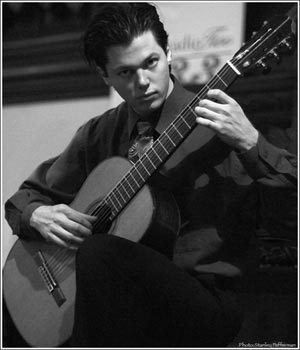 |
|
2004 Ottawa International Chamber Music Festival
|
| July 30, 2004 |
|
Daniel Bolshoy
With his right hand alone, the guitarist sounds all the notes that a pianist plays with both hands. The notes are 'chosen' by pressing the four fingertips of the left hand along a fingerboard that has six strings and more than twelve frets. To play four full sonatas, and to do it from memory, with feeling and a sense of the dynamics of each piece is a feat that seems to me equivalent to brain surgery or rocket science.
The classical guitar possesses a quiet, private voice. To get the fullest possible range of dynamics, the guitarist must be able to make notes sharp as a cracking bone, notes deep and rich as rosewood, and notes that fall as quietly as feathers yet fill an entire hall. Daniel Bolshoy accomplished this miracle last night during his recital of Great Sonatas for Guitar.
|
Twenty-something and good-looking, Daniel Bolshoy has been in training with great teachers and is poised to challenge the rock pillar of the guitar world which is the pedestal of Andres Segovia, whose presence Bolshoy invoked, with respect and a hint of challenge, during his skillful, informative and charming historical introductions to each of the sonatas. What Segovia would have liked or would not have liked was always an issue in the story of most of the pieces, because they were commissioned by or written for Segovia, except for the last piece by Antonio Jose´, which was not played until sixty years after his execution by the forces of Franco. Bolshoy, in a characteristically humorous remark, said that it has to be played in a way to deceive you into thinking it is guitar music. It sounded to me, especially in the third movement, "pavane triste", like the kind of melancholy blues Miles or Monk might have played at the Village Vanguard, in those days of old.
|
|

Daniel Bolshoy |
|
|
|
| July 30, 2004 |
| The Music of Brahms
The music of Brahms brings me back to places I've never been before. Eighteenth century castles on the Rhine, the rolling fields of grain beyond being harvested by peasants concluding their toil in the setting sun while barefoot milkmaids bring in the lowing cows. The European pastoral scene with it's dances, festivals, seasonal moods, peaceful, stormy and sublime.
Do we replay and relisten to this music simply because the broad roots of our new world culture emanate from mother Europe? Or are we connected to something deeper than lineage or nostalgia? Could it be the scenes of pastoral or city or court life that sustain the drama of Brahms' music reflect images of a world that always exists in our deeper minds but doesn't take shape for our reflection until a musician or a poet gives them a 'local shape and habitation'?
This year the Festival is featuring the Chamber Music of Brahms in a series of fourteen concerts. The Quintet for Strings in G major, opus 111, no.2,and the Sextet for Strings in B-flat major, opus 18, no.1, beautifully played by Stephen Sitarksi, Marie Be´dard, Steven Dann, Guylaine Lemaire, Denise Djokic, and Thomas Weibe, bring these reflections.
|
|
|
|
Report and photograph by Stanley Fefferman
|
|
|
|
|


